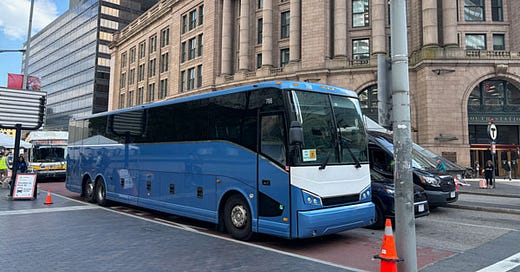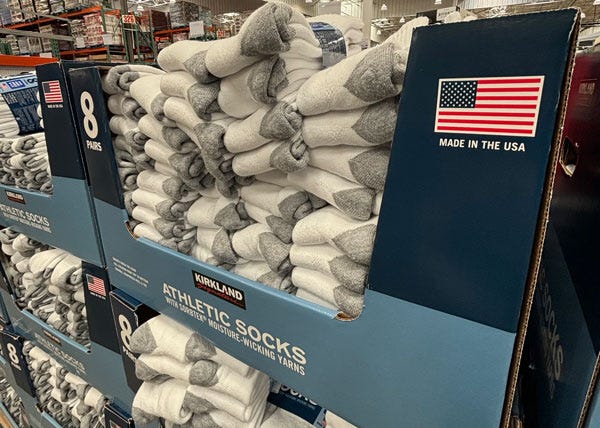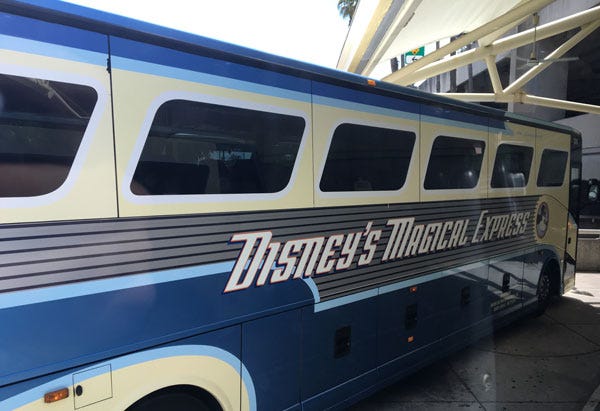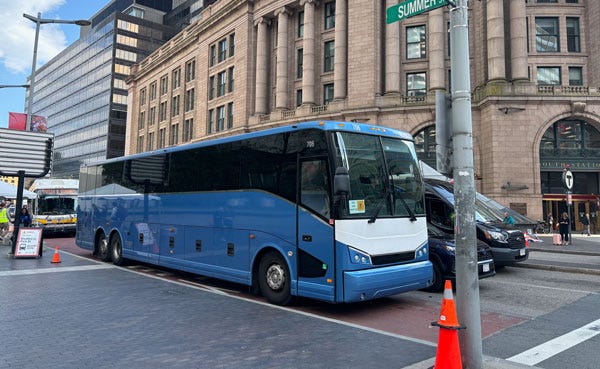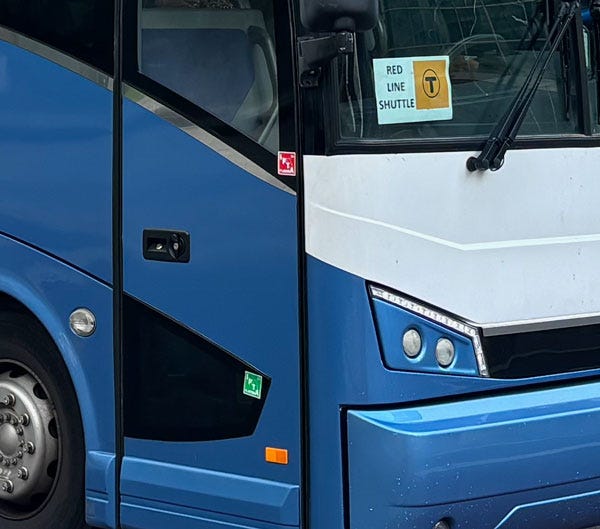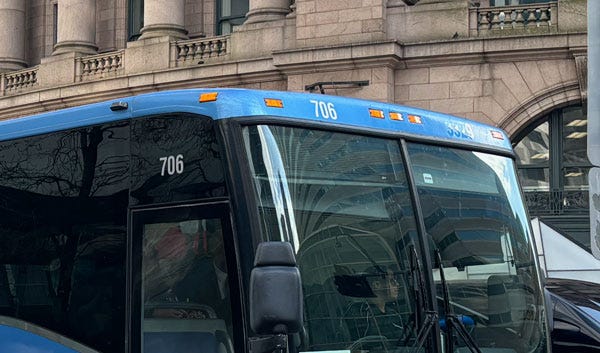Wednesday Walk: The Mysterious Blue Bus
Finding some socks that don't fully exploit workers and the planet, a bus with a backstory
Welcome to Willoughby Hills!
Every Wednesday, I offer a few short ideas that I hope will inspire you to do some more reading, thinking, and exploring. Let’s take a little walk together and see where the path leads…
#NoNewClothes- Week 82
Back in October, 2022, I challenged myself and my readers to try to go an entire year without buying new clothes. (I also had some thoughts on the Cybertruck and AI imagery in that same issue, which seems to be proof that everything goes in cycles.)
A part of the reason for the No New Clothes Challenge was simply to cut unnecessary consumption. Another part was to opt out of an exploitative system, often using forced labor in China or underpaid labor in countries like Bangladesh to produce cheap clothing. (For a great firsthand account of these problems, listen to my podcast with author Amelia Pang whose work chronicled Uyghur forced labor in China).
I was less aware of the fashion waste issues at the time this challenge launched, but have since talked to fashion designer Francisca Gajardo on the podcast, who grew up near one of the world’s largest clothing dumps in the Atacama Desert of Chile. Seeing the clothing waste from Western fashion brands inspired her to rethink how she makes clothes.
As for my Challenge, I managed to make it an entire year only buying one new shirt, plus one thrifted sweater and a thrifted shirt.
When that challenge ended in October, 2023, I planned to continue to document my clothing purchases in this newsletter. My mentality around consumption had shifted by not buying new clothes, and it felt noteworthy to talk about when I bought something new.
But then, strangely enough, I didn’t end up buying much more. In fact, I bought three thrifted shirts in November, 2023, and nothing since.
The time came recently to purchase some new socks. Knowing what I do about the problems with the fashion industry, I felt a bit like Chidi Anagonye, the character played by William Jackson Harper on The Good Place. Chidi always tries so hard to do the right thing that he is either too paralyzed to do anything or ends up doing more harm by trying too hard.
Knowing the labor issues in China and Bangladesh, I wanted to avoid socks made in those countries. Knowing the polluting effects of synthetic fabrics, I wanted something that was all cotton or mostly cotton. I wanted well made socks that would last so that I wouldn’t have to discard them after a few months. But, not being super wealthy and knowing that they were just socks, I didn’t want to spend a fortune on new socks.
I was in Costco the other day, which is where I used to buy my socks before I gave it much thought. I didn’t expect to find what I needed there, but figured I would at least look. I was a bit surprised by what I found!
Costco was selling American made tube socks in an 8 pack for under $15. I was pleasantly surprised.
The socks were 64% cotton, with the remainder being synthetics (polyester, nylon, and spandex). They weren’t 100% cotton, but when I checked other socks nearby, many were fully synthetic, so 64% cotton was an improvement. Also, I assume socks need some kind of elastic or other stretch material to stay on and not fall, so maybe a 100% cotton sock doesn’t even exist.
Costco is also known for selling higher quality products, perhaps in part because they offer such a generous return policy that their items need to be fairly durable.
I decided not to let perfect be the enemy of good and ended up buying my first new socks in nearly two years. (I bought my last package of socks from Target in a panic when my luggage was lost on a flight to Kansas City in 2022. Those socks have all nearly disintegrated now).
You might wonder what the point is in being so meticulous about something as insignificant as socks. In my opinion, that’s the indoctrination of capitalism talking. Good consumers don’t think too hard about where things come from or why they’re so cheap- they just buy, buy, buy. And then suddenly there’s a clothing dump in Chile that can be seen from space.
I am meticulous about where my clothing comes from because I don't want to support global systems of oppression. I’m meticulous about where my food comes from because locally grown food is more nutritious and has a lower environmental impact than trucking things from California or Mexico. These little decisions matter and they add up.
Another Vehicle with History
Last week, I wrote about discovering that the Red Line train I was riding in Boston may have been put into service before Neil Armstrong landed on the moon. In fact, had it not been for an antique map that mistakenly was uncovered, I may not have realized that I was often riding on trains that old.
One of the downsides of having such an old subway system is that it breaks and sections of track need to be closed for repairs. That happened on the Red Line earlier this month, as shuttle buses replaced trains for much of the train route through Downtown Boston.
Lately, when the subway has been out of service, the MBTA has been hiring private motor coaches as replacements instead of city buses. These are the kind you might take on a long trip or with a tour group that have plush seats and TVs.
A few weeks ago, I noticed that one of these shuttle buses looked a little different than the other yellow coach buses that were in circulation. This one was blue and black and was very familiar to me. Do any of you recognize it?
It was a bit strange seeing a bus like this right in front of South Station in the heart of Boston, because to me, this looked nearly identical to the buses that Mears Connect uses to shuttle passengers from Orlando International Airport to Walt Disney World Resort hotels. Here’s what a Mears Connect bus looks like:

Mears Connect runs $16 per adult and $13 per child one way between the airport and the hotel, but at one time, this was a very different service, which is why it was so familiar to me.
Between 2005 and 2022, Disney offered bus service as a free perk to people staying at one of their owned and operated hotels at Walt Disney World. The coaches were technically staffed and operated by Mears, but they went by the name Disney’s Magical Express.
As I’ve written about before, Disney has some of the best “public” transportation in the country (buses, boats, monorails, and gondolas all move people across their property for free). By offering Disney bus service from the airport to the hotel, Disney made transportation easy for guests, but it also allowed them to have a captive audience in Orlando. There was less friction to spending all vacation time (and vacation money) at Disney parks, hotels, and restaurants, so many guests never left to see Universal, Sea World, Kennedy Space Center, the beach, or even eat at a local restaurant.
According to news reports, Magical Express moved up to 14,000 people per day to and from the airport. Placing that many people on shared coaches instead of individual taxis or rental cars was a net positive to traffic and pollution for the community.
The idea of being “captive” at one resort complex may sound stifling, but Disney found ways to make it advantageous to the guest too. A few weeks in advance, they mailed special luggage tags to guests. When checking luggage at their departing airport (in my case Boston), you would add these tags to your bag at check in. Upon arriving in Orlando, the specially tagged bags were taken to a separate area, loaded on a truck, and delivered directly to a guest’s room. Once I dropped my bag at the ticket counter in Boston, I didn’t see it again until it was in my hotel room- no stop at baggage claim required!
The motor coaches also didn’t require car seats, so when our children were small, a quick flight to Orlando was a welcome getaway with two babies. We didn’t have to worry about baggage, didn’t need to pack car seats, and could take “public” transportation (which also didn’t require car seats) to visit other hotels, restaurants, and shops within Disney’s complex (which includes nearly 30 hotels and dozens of restaurants).
It’s unclear why Disney decided to end its contract with Mears and discontinue the free Magical Express. The announcement happened rather abruptly in 2021, with service ending January 1, 2022.
The shortsightedness of this decision from a business and environmental standpoint are beyond the scope of today’s post, but I was not happy when this service ended, the Disney branding was stripped from the buses, and it was suddenly a paid service that no longer offered luggage delivery.
I also think there’s a lot to be learned from Disney’s version of transportation that could inform cities, but again, that’s not the discussion for today.
At any rate, the question remains- was that actually a Mears bus in Downtown Boston or just a random lookalike? There were two clues which lead me to believe this was actually a decommissioned Mears bus.
The first is that this bus, like many commercial vehicles has IFTA stickers on it, which stands for International Fuels Tax Agreement. What’s an IFTA sticker? Well, according to the Commonwealth of Massachusetts:
“IFTA is an agreement between the mainland U.S. states and the Canadian provinces requiring a carrier to register and report the fuel use of any qualified motor vehicle that operates in more than one jurisdiction.”
IFTA stickers usually feature an outline of the state where the vehicle is registered. Look what’s on this bus:
It may be hard to tell in these low res photos, but both stickers have the shape of Florida on them.
Even more telling perhaps is the bus number. This bus is now numbered as 706, as seen above the passenger side window. But above the driver’s side, a faint “3329” can be seen, as though it was removed.
In looking back at photos of Magical Express and Mears Connect buses, they seem to have a similar numbering convention of using four digits, the first being a 3. In fact, I found a photo of a bus 3329 on a blog, which I believe to be this exact bus in its former life in Florida. That blog claims that this bus was the last bus to be used as a Magical Express bus, departing Disney’s Pop Century for the Airport on January 10, 2022.
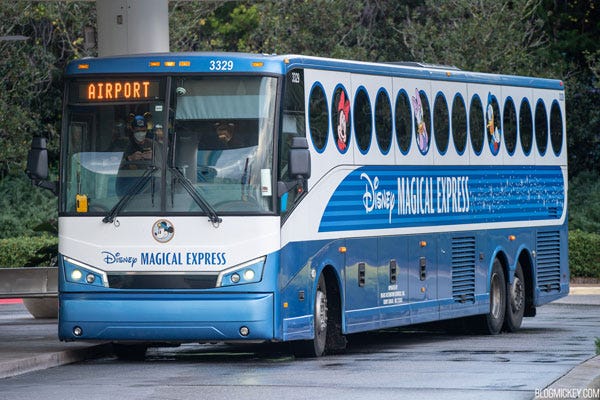
I have no idea whether this bus had its wrapping removed and was operated as a Mears Connect before being sold to a New England based carrier, but at some point, it ended up in Boston doing short runs between Park Street and JFK/UMass stations. Wild!
I wonder if anyone else was struck with familiarity when they saw that random blue bus in Boston this month, or if it just blended in with the other Greyhounds and Peter Pans around it and nobody gave it a second thought?
I’m glad that I did, and I’m glad that the massive internet database helped me find some of the missing pieces in this story.
I publish new issues every Wednesday and Sunday. Sign up to always receive the latest issue and support my work:
Other Wednesday Walks
If you’ve missed past issues of this newsletter, they are available to read here.


